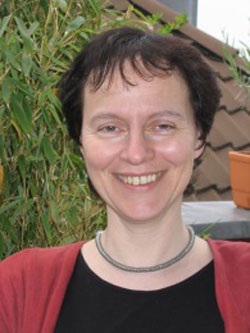 This morning, Esther Beneish
This morning, Esther Beneish
arxived the paper The center of the generic algebra of degree p that may contain the most
significant advance in my favourite problem for over 15 years! In it she
claims to prove that the center of the generic division algebra of
degree p is stably rational for all prime values p. Let me begin by
briefly explaining what the problem is all about. Consider one n by n
matrix A which is sufficiently general, then it will have all its
eigenvalues distinct, but then it is via the Jordan normal form theorem uniquely
determined upto conjugation (that is, base change) by its
characteristic polynomial. In
other words, the conjugacy class of a sufficiently general n by n matrix
depends freely on the coefficients of the characteristic polynomial
(which are the n elementary symmetric functions in the eigenvalues of
the matrix). Now what about couples of n by n matrices (A,B) under
simultaneous conjugation (that is all couples of the form $~(g A
g^{-1}, g B g^{-1}) $ for some invertible n by n matrix g) ??? So,
does there exist a sort of Jordan normal form for couples of n by n
matrices which are sufficiently general? That is, are there a set of
invariants for such couples which determine it is freely upto
simultaneous conjugation?
 For couples of 2 by 2 matrices, Claudio Procesi rediscovered an old
For couples of 2 by 2 matrices, Claudio Procesi rediscovered an old
result due to James Sylvester saying
that this is indeed the case and that the set of invariants consists of
the five invariants Tr(A),Tr(B),Det(A),Det(B) and Tr(AB). Now, Claudio
did a lot more in his paper. He showed that if you could prove this for
couples of matrices, you can also do it for triples, quadruples even any
k-tuples of n by n matrices under simultaneous conjugation. He also
related this problem to the center of the generic division algebra of
degree n (which was introduced earlier by Shimshon Amitsur in a rather
cryptic manner and for a while he simply refused to believe Claudio’s
description of this division algebra as the one generated by two
_generic_ n by n matrices, that is matrices filled with independent
variables). Claudio also gave the description of the center of this
algebra as a field of lattice-invariants (over the symmetric group S(n)
) which was crucial in subsequent investigations. If you are interested
in the history of this problem, its connections with Brauer group
problems and invariant theory and a short description of the tricks used
in proving the results I’ll mention below, you might have a look at the
talk Centers of Generic Division Algebras, the rationality problem 1965-1990
I gave in Chicago in 1990.
 The case of couples of 3 by 3 matrices was finally
The case of couples of 3 by 3 matrices was finally
settled in 1979 by Ed Formanek and a
year later he was able to solve also the case of couples of 4 by 4
matrices in a fabulous paper. In it, he used solvability of S(4) in an
essential way thereby hinting at the possibility that the problem might
no longer have an affirmative answer for larger values of n. When I read
his 4×4 paper I believed that someone able to prove such a result must
have an awesome insight in the inner workings of matrices and decided to
dedicate myself to this problem the moment I would get a permanent
job… . But even then it is a reckless thing to do. Spending all of
your time to such a difficult problem can be frustrating as there is no
guarantee you’ll ever write a paper. Sure, you can find translations of
the problem and as all good problems it will have connections with other
subjects such as moduli spaces of vectorbundles and of quiver
representations, but to do the ‘next number’ is another matter.
 Fortunately, early 1990, together with
Fortunately, early 1990, together with
Christine Bessenrodt we were
able to do the next two ‘prime cases’ : couples of 5 by 5 and couples of
7 by 7 matrices (Katsylo and Aidan Schofield had already proved that if
you could do it for couples of k by k and l by l matrices and if k and l
were coprime then you could also do it for couples of kl by kl matrices,
so the n=6 case was already done). Or did we? Well not quite, our
methods only allowed us to prove that the center is stably rational
that is, it becomes rational by freely adjoining extra variables. There
are examples known of stably rational fields which are NOT rational, but
I guess most experts believe that in the case of matrix-invariants
stable rationality will imply rationality. After this paper both
Christine and myself decided to do other things as we believed we had
reached the limits of what the lattice-method could do and we thought a
new idea was required to go further. If today’s paper by Esther turns
out to be correct, we were wrong. The next couple of days/weeks I’ll
have a go at her paper but as my lattice-tricks are pretty rusty this
may take longer than expected. Still, I see that in a couple of weeks
there will be a meeting in
Atlanta were Esther
and all experts in the field will be present (among them David Saltman
and Jean-Louis Colliot-Thelene) so we will know one way or the other
pretty soon. I sincerely hope Esther’s proof will stand the test as she
was the only one courageous enough to devote herself entirely to the
problem, regardless of slow progress.
